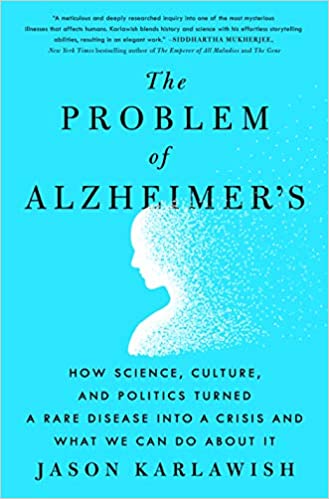Jason Karlawish
New York
St. Martin’s Press
2021
324 pages
According to the art:
The book might have been better titled, The Problems of Alzheimer’s, to better reflect the multiple dimensions Jason Karlawish takes into account in his study of the disease. Karlawish functions more as critic than cheerleader, and more as an arbiter than polemicist. He is only a polemicist when criticizing the polemics around various controversies he considers.
Synopsis:
In a 1976 Archives of Neurology essay, the neurologist Robert Katzman successfully argued for relabeling “senility” as “Alzheimer’s disease.” He urged rejecting various forms of dementia and senility as common consequences of aging, and accepting them as a disease requiring all the attention any other important disease deserves. Now medicine and society had a problem—”The Problem of Dementia,” as the famed physician Lewis Thomas called it in a 1981 essay published by the popular magazine Discover. And, he noted further, “a disease of the century” had arisen. (p. 3)
Forty years on, Jason Karlawish thinks there is still a problem, but in keeping with Katzman’s call, he refers to “The Problem with Alzheimer’s.” Based on the history he covers and the experiences he shares in this book, nothing of much significance has occurred since “The Problem of Dementia” became the “The Problem of Alzheimer’s.”
Karlawish is a physician who cares for people with Alzheimer’s and a researcher who delves into “issues at the intersections of care, ethics, and policy.” (p. 5) He draws on his experiences in this book, which he describes as “the story of how once upon a time, Alzheimer’s disease was a rare disease, and then it became common, and then it turned into a crisis.” Karlawish wants to answer why during the time between Thomas’ essay and the year 2010, “nothing really changed,” and how that could be the case in “the richest and most powerful nation.” (p. 6) He tells this story in four parts.
The first part concentrates on efforts clinicians and researchers were making following Thomas’ call to distinguish Alzheimer’s disease from normal aging, other dementia types (e.g., frontotemporal, Lewy body), and precursor syndromes). They were looking for definitive clinical patterns, imaging studies, diagnostic tests, and pathologic markers for the disease.
In the second part, Karlawish goes back in time to when Alois Alzheimer first found what are known today as “plaques” in the brain of a patient who had an early onset of severe, progressive dementia. He traces the attention this finding drew to eventual advances in imaging and biochemistry aimed at diagnosis. Karlawish also covers how a cascade of events over the decades following Alois Alzheimer’s finding disrupted the pursuit of a pathophysiological basis for dementia. These events included the rise and dominance of Freudian psychology; two world wars; the cold war; the overshadowing of AIDS; Medicare political and funding constraints; tussles among patient advocacy groups; loss of asylums where care and research had coexisted; clinical failure of the first drug; and the continued debate over whether dementia is a consequence of aging or of a disease.
Karlawish moves on in the third and fourth parts to address what “we will have to learn to live with the disease so as to improve the lives of persons…to provide the care they need to live well at home…and repair the broken system.” (p. 171) Success in his view requires integrated biological, psychological, and social components. He reports the progress on each of these three fronts: some failed approaches continue to fail (such as drugs targeting amyloid); some psychological interventions show promise (though at times causing moral tension); and some of the social configurations engineered for Alzheimer’s patients, families, caregivers, and society have produced some triumphs and some disasters. He has a lot to say about why and how this search must go on, but with some much-needed course corrections.
Analysis:
The book might have been better titled, The Problems of Alzheimer’s, to better reflect the multiple dimensions Karlawish takes into account in his study of the disease.
The problem of Alzheimer’s disease isn’t simply a scientific puzzle to be solved, a menace of “druggable” pathologies to be conquered. It’s the vortex of the scientific, political, cultural, and social problems of aging and disability. It is a humanitarian problem.
p. 230
Karlawish is well situated for gaining insights on many aspects of Alzheimer’ disease from many directions. There are his direct patient care roles as a co-director of the Penn Memory Center; his research activities encompassing both finding cures and improving care; his academic appointments in Medicine, Medical Ethics and Health Policy, and Neurology; and his activism mainly through public speaking, media appearances, and writings in mainstream media and professional publications. Karlawish approaches Alzheimer’s disease with the zeal of the converted. He had gone a long way towards becoming a specialist in critical care medicine having completed an internal medicine residency and one year of a critical care fellowship. He then redirected his training to geriatric medicine because, as he explains it, “the health care system killed my grandfather,” when the health care team managing his grandfather’s hip fracture could not make the necessary adjustments for his concomitant dementia. (p. 173)
The book is thus a wider view of Alzheimer’s disease than a deeper view of any singular aspect of it. Karalawish comes across more as critic than cheerleader, and more as an arbiter than polemicist. Indeed, he is only a polemicist when criticizing the polemics around various controversies such as whether a funding emphasis should be placed on finding a cure or improving care; he thinks they are equally worthy of emphasis.
Karlawish aptly infers that Katzman’s success in rolling up many types of dementia under “Alzheimer’s disease” is, ironically, at the root of The Problem of Alzheimer’s. “The story that older adults with dementia typically had Alzheimer’s disease caused by amyloid plaques and tau tangles was too simple. A single word summarized the results of decades of research: heterogeneity.” (p. 228) A more prosaic form comes from one of Karlawish’s colleagues: “The least common form of Alzheimer’s disease is Alzheimer’s disease.” (p. 229)
Modern-day bioscience contributes to the problem of Alzheimer’s as well with its propensity over the decades for supporting predominant theories in the face of counterfactuals and clinical failures. Karlawish notes how the Alzheimer’s disease narrative is susceptible to perpetuation of refuted or ungrounded theories and research priorities: “It was the kind of disease that neurologists and psychiatrists, clinicians and investigators could make into a career. Grants and, for some researchers, lucrative corporate consulting followed.” (p. 155) Rare is the study report that closes the chapter on a particular theory or research agenda. More often the conclusion is, “additional research is needed.”
Karlawish calls out the clinical trial experience with drugs that reduce amyloid as a case in point. While they reduced amyloid plaques on imaging studies, patients did not show corresponding clinical benefits. Further development of these drugs had been shut down as a result. “The field was gathering failed trials like a stamp collection.” (p. 226) However, further analysis of one of the drugs, aducanumab, revealed a slower decline in cognition amongst a subgroup of patients receiving highest dose. The timeline for the book ends when the sponsoring company for aducanumab announced it planned to seek FDA approval for the drug. Despite findings of little clinical benefit and considerable risk, and the FDA advisory committee’s unanimous vote (but for one “present”) not to approve recommendation for approval, aducanumab won approval anyway. Though it was the first approval in twenty-five years for an Alzheimer’s disease drug, the decision drew criticism from many quarters. Karlawish joined the chorus saying publicly that the aducanumab approval was one of the worst in FDA history.
The cruel history of Alzheimer’s disease continues apace.
Also:
A version of this post appears in the NYU Literature, Arts and Medicine Database.



